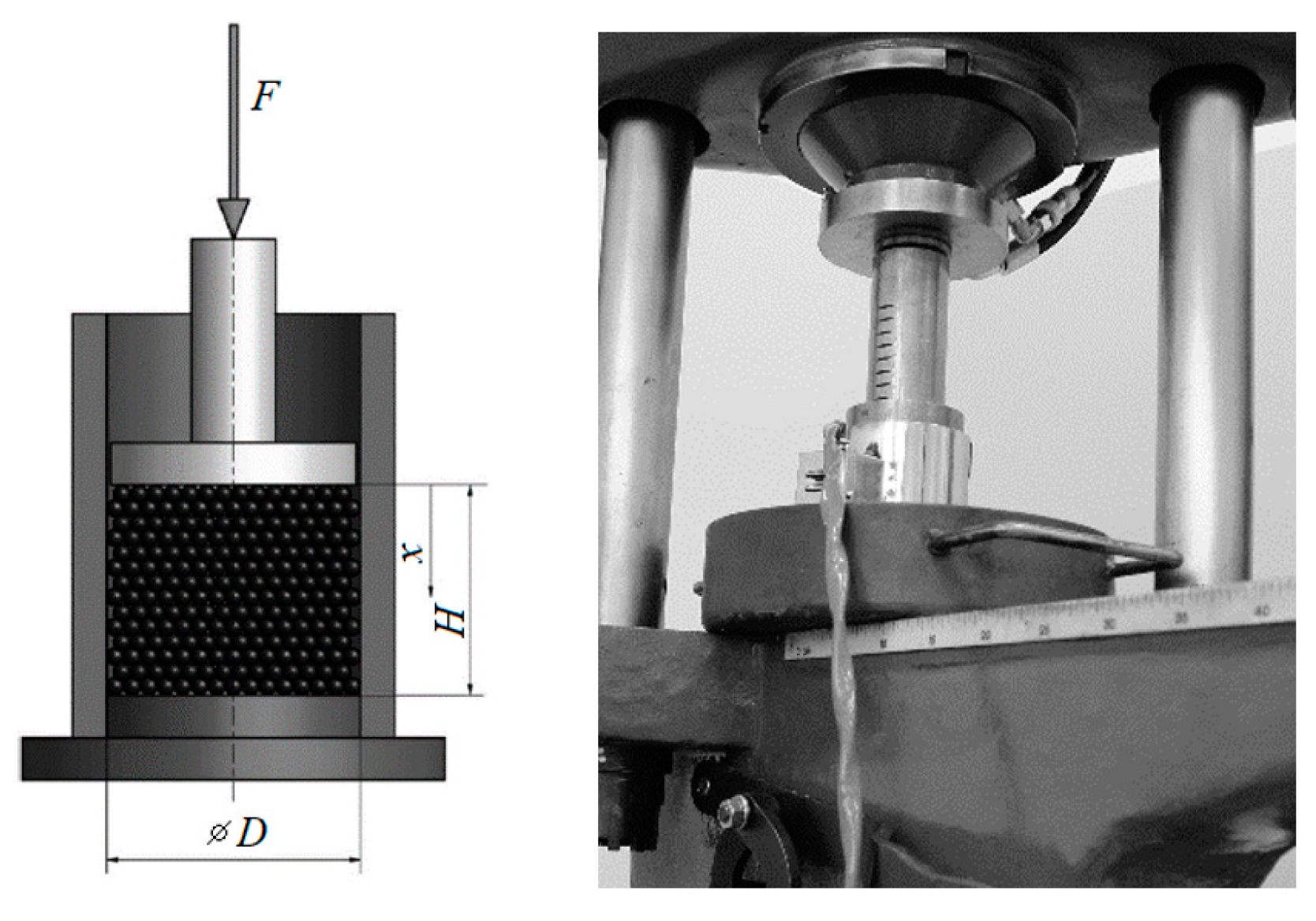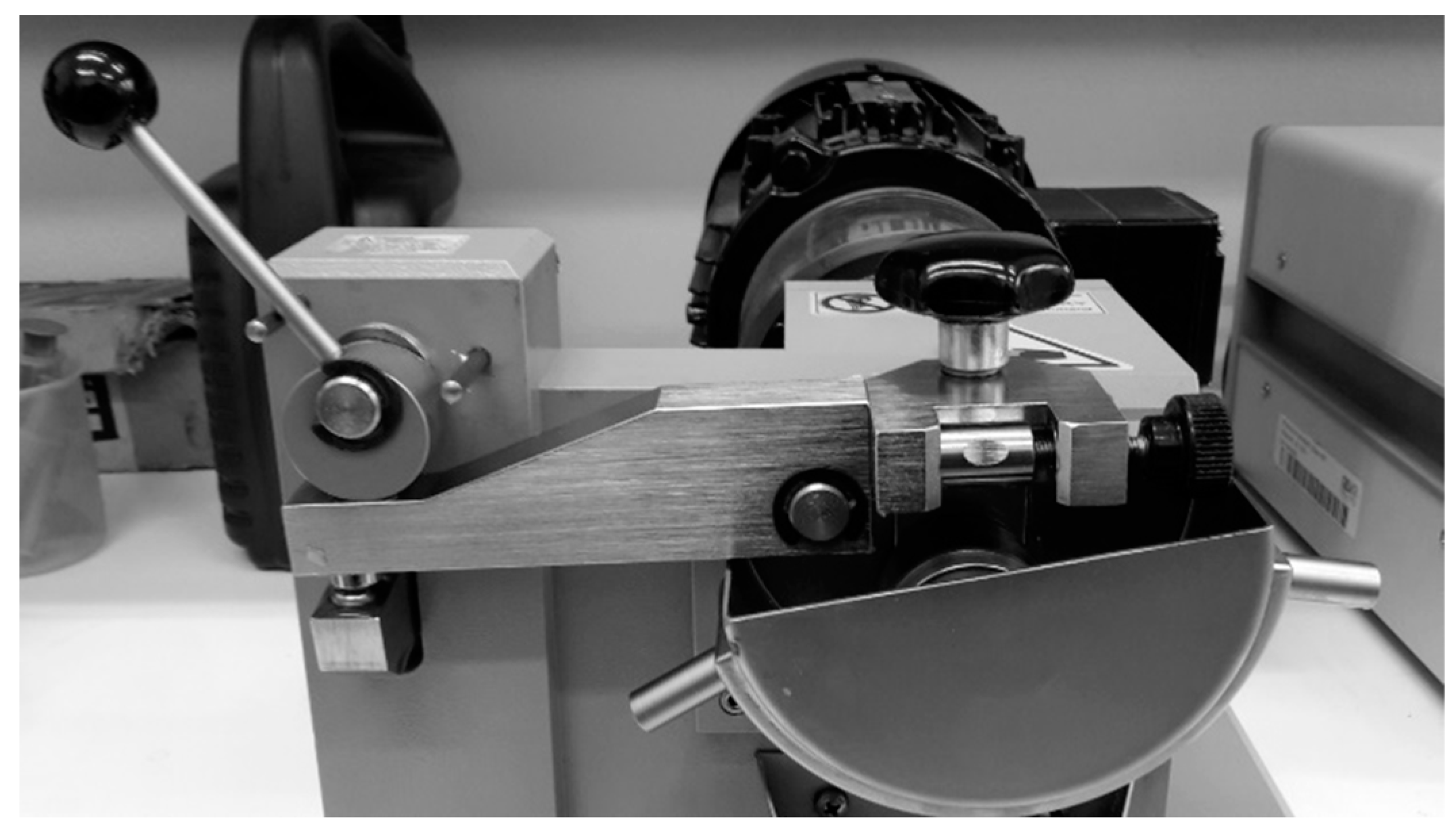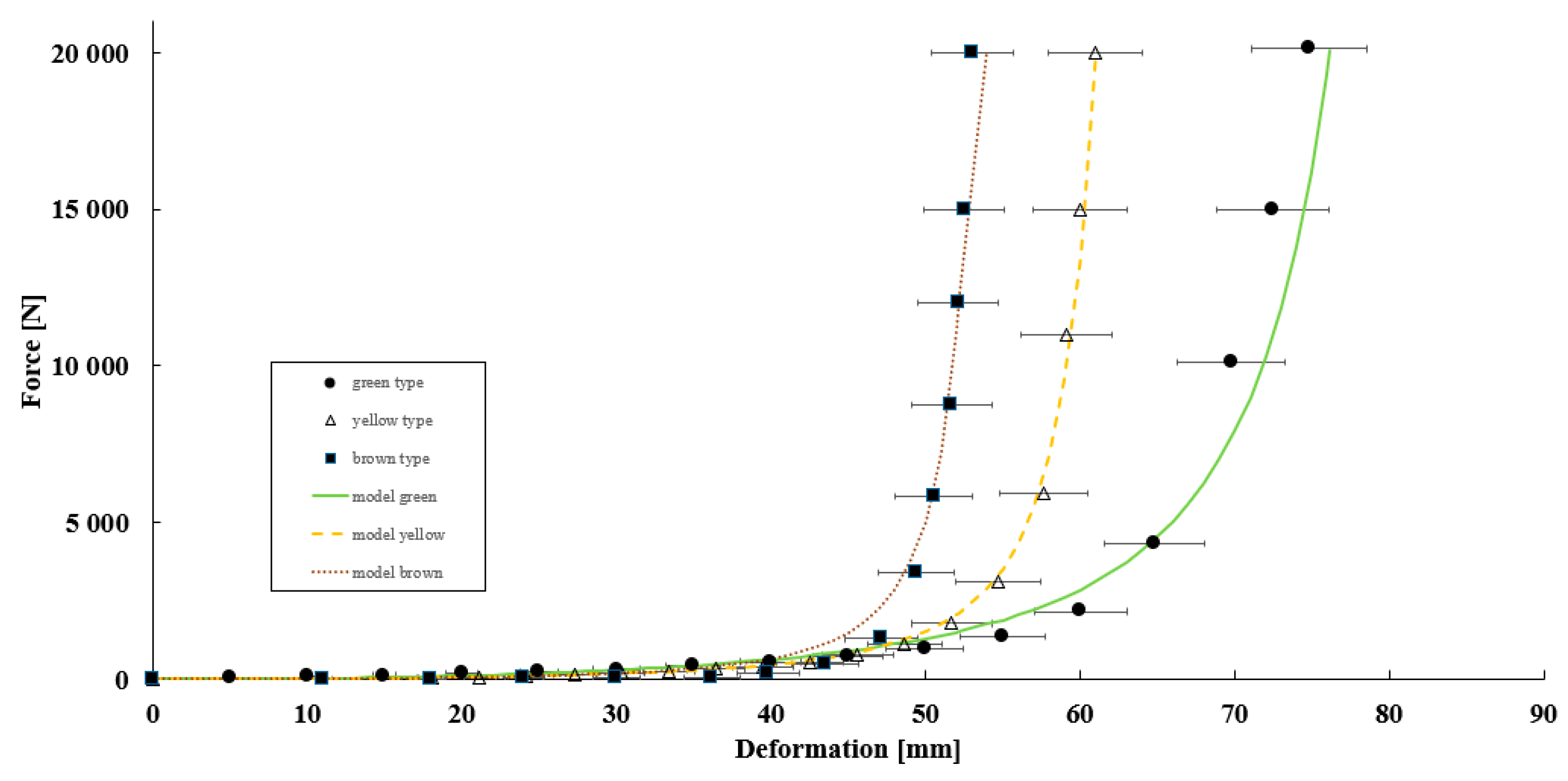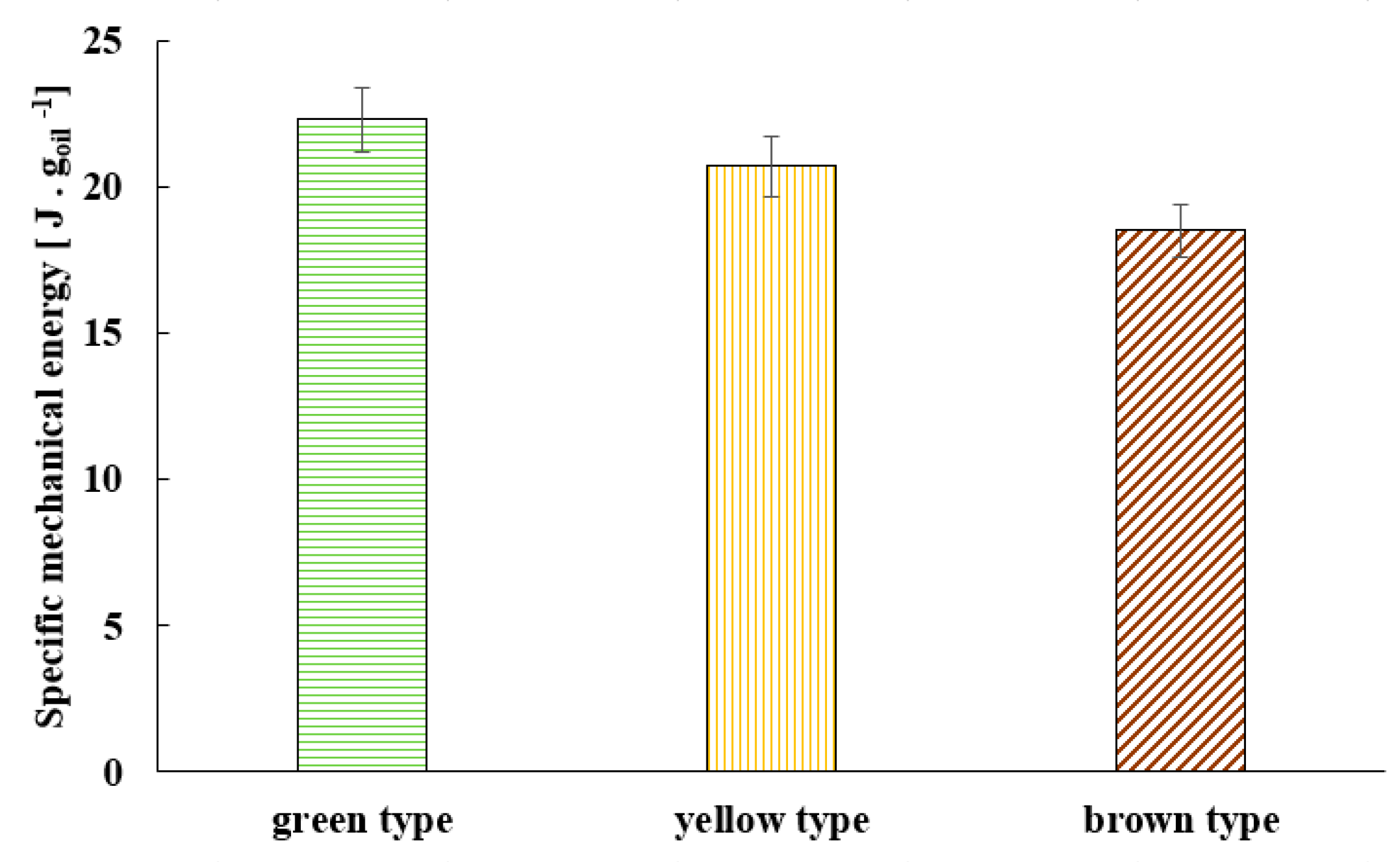Mechanical Pressing of Coconut Oil and Evaluation of Its Lubricant Properties
Abstract
:1. Introduction
2. Materials and Methods
2.1. Coconuts
2.2. Compression Tests
2.3. Analysis of Lubrication Properties
2.4. Analysis of the Wear Surface Using an Electron Microscope
2.5. Determination of UV Spectral Parameters
3. Results
4. Conclusions
Author Contributions
Funding
Data Availability Statement
Conflicts of Interest
References
- Yong, J.W.H.; Ge, L.; Ng, Y.F.; Tan, S.N. The Chemical Composition and Biological Properties of Coconut (Cocos nucifera L.). Water. Mol. 2009, 14, 5144–5164. [Google Scholar] [CrossRef] [PubMed]
- Pandiselvam, R.; Kaavya, R.; Martinez Monteagudo, S.I.; Divya, V.; Jain, S.; Khanashyam, A.C.; Kothakota, A.; Prasath, V.A.; Ramesh, S.V.; Sruthi, N.U.; et al. Contemporary Developments and Emerging Trends in the Application of Spectroscopy Techniques: A Particular Reference to Coconut (Cocos nucifera L.). Molecules 2022, 27, 3250. [Google Scholar] [CrossRef]
- Ionescu, M.; Voicu, G.; Biriș, S.-Ș.; Matache, M.; Ștefan, E.M. Mathematical models for expressing the oil extraction at screw presses. Sci. Bull. Univ. Politeh. Buchar. Ser. D Mech. Eng. 2015, 77, 249–260. [Google Scholar]
- Ionescu, M.; Voicu, G.; Biriș, S.Ș.; Ștefan, E.M.; Ungureanu, N.; Dincă, M. Determination of some mechanical properties for oilseeds using uniaxial compression tests. INMATEH Agric. Eng. 2016, 49, 71–76. [Google Scholar]
- Cristea, O.D.; Catană, L.; Brăcăcescu, C.; Bălțatu, C.; Vlăduțoiu, L.; Grigore, I.; Ungureanu, N. Processing methods of wine by-products to obtain grape seed oil and grape seed flour as functional ingredients for food fortification. In Proceedings of the 48th International Symposium “Actual Tasks on Agricultural Engineering”, Croatia, Opatija, 2–4 March 2021; pp. 445–454. [Google Scholar]
- Sorokova, N.; Didur, V.; Variny, M. Mathematical Modeling of Heat and Mass Transfer during Moisture–Heat Treatment of Castor Beans to Improve the Quality of Vegetable Oil. Agriculture 2022, 12, 1356. [Google Scholar] [CrossRef]
- Bargale, P.C. Mechanical Oil Expression from Selected Oilseeds under Uniaxial Compression; University of Saskatchewan: Saskatoon, SK, Canada, 1997. [Google Scholar]
- Khor, Y.P.; Koh, S.P.; Long, K.; Long, S.; Ahmad, S.Z.; Tan, C.P. A comparative study of the physicochemical properties of a virgin coconut oil emulsion and commercial food supplement emulsions. Molecules 2014, 19, 9187–9202. [Google Scholar] [CrossRef]
- Jayadas, N.H.; Nair, K.P.; Ajithkumar, G. Tribological evaluation of coconut oil as an environment-friendly lubricant. Tribol. Int. 2007, 40, 350–354. [Google Scholar] [CrossRef]
- Pengon, S.; Chinatangkul, N.; Limmatvapirat, C.; Limmatvapirat, S. The effect of surfactant on the physical properties of coconut oil nanoemulsions. Asian J. Pharm. Sci. 2018, 13, 409–414. [Google Scholar] [CrossRef] [PubMed]
- Nevin, K.G.; Rajamohan, T. Virgin coconut oil supplemented diet increases the antioxidant status in rats. Food Chem. 2006, 99, 260–266. [Google Scholar] [CrossRef]
- Zareh-Desari, B.; Davoodi, B. Assessing the lubrication performance of vegetable oil-based nano-lubricants for environmentally conscious metal forming processes. J. Clean. Prod. 2016, 135, 1198–1209. [Google Scholar] [CrossRef]
- Sajeeb, A.; Rajendrakumar, P.K. Comparative evaluation of lubricant properties of biodegradable blend of coconut and mustard oil. J. Clean. Prod. 2019, 240, 118–255. [Google Scholar] [CrossRef]
- Erhan, S.Z.; Sharma, B.K.; Perez, J.M. Oxidation and low temperature stability of vegetable oil-based lubricants. Ind. Crops Prod. 2006, 24, 292–299. [Google Scholar] [CrossRef]
- Ohkawa, S.A.; Konishi, H.; Hatano, K.; Tanaka, K.; Iwamura, M. Oxidation and corrosion characteristics of vegetable base biodegradable hydraulic oils. J. Fuels Lubr. 1995, 104, 737–745. [Google Scholar]
- Mannekote, J.K.; Kailas, S.V.; Venkatesh, K.; Kathyayini, N. Environmentally friendly functional fluids from renewable and sustainable sources. Renew. Sustain. Energy Rev. 2018, 81, 1787–1801. [Google Scholar] [CrossRef]
- Srivastava, A.; Sahai, P. Vegetable oils as lube basestocks: A review. Afr. J. Biotechnol. 2013, 12, 880–891. [Google Scholar]
- Panchal, T.M.; Patel, A.; Chauhan, D.D.; Thomas, M.; Patel, J.V. A methodological review on bio-lubricants from vegetable oil based resources. Renew. Sustain. Energy Rev. 2017, 70, 65–70. [Google Scholar] [CrossRef]
- Torrecilla, J.S.; Rojo, E.; Domínguez, J.C.; Rodríguez, F. Linear and non linear chemometric models to quantify the adulteration of extra virgin olive oil. Talanta 2010, 83, 404–409. [Google Scholar] [CrossRef]
- Leong, Y.S.; Ker, P.J.; Jamaludin, M.Z.; Nomanbhay, S.M.; Ismail, A.; Abdullah, F.; Looe, H.M.; Lo, C.K. UV-Vis Spectroscopy: A New Approach for Assessing the Color Index of Transformer Insulating Oil. Sensors 2018, 18, 2175. [Google Scholar] [CrossRef]
- Zhou, J.; Xiong, Y.; Gong, Y.; Liu, X. Analysis of the oxidative degradation of biodiesel blends using FTIR, UV–Vis, TGA and TD-DES methods. Fuel 2017, 202, 23–28. [Google Scholar] [CrossRef]
- Macián, V.; Tormos, B.; Barberá, A.G.; Balaguer, A. Application assessment of UV–vis and NIR spectroscopy for the quantification of fuel dilution problems on used engine oils. Fuel 2023, 333, 126350. [Google Scholar] [CrossRef]
- Tan, T.H.; Cheng, L.H.; Bhat, R.; Rusul, G.; Easa, A.M. Composition, physicochemical properties and thermal inactivation kinetics of polyphenol oxidase and peroxidase from coconut (Cocos nucifera) water obtained from immature, mature and overly-mature coconut. Food Chem. 2014, 142, 128. [Google Scholar] [CrossRef] [PubMed]
- Jackson, J.C.; Gordon, A.; Wizzard, G.; McCook, K.; Rolle, R. Changes in chemical composition of coconut (Cocos nucifera) water during maturation of the fruit. J. Sci. Food Agric. 2004, 84, 1049–1052. [Google Scholar] [CrossRef]
- ASAE S410.1 DEC97; Moisture Measurement of Peanut. The Society for Engineering in Agricultural, Food, and Biological Systems: St. Joseph, MI, USA, 1998; pp. 560–561.
- Kabutey, A.; Herak, D.; Chotěborský, R.; Dajbych, O.; Divišová, M.; Boarti, W.E. Linear pressing analysis of Jatropha curcas L. seeds using different pressing vessel diameters and seed pressing heights. Biosyst. Eng. 2013, 115, 43–49. [Google Scholar] [CrossRef]
- Marquardt, D.W. An algorithm for the least-squares estimation of nonlinear parameters, SIAM. J. Appl. Math. 1963, 11, 431–441. [Google Scholar]
- Lourakis, M.I.A. A Brief Description of the Levenberg-Marquardt Algorithm Implemented by Levmar. Foundation for Research and Technology. 2005. [Google Scholar]
- Herák, D.; Gurdil, G.; Sedlaček, A.; Dajbych, O.; Simanjuntak, S. Energy demands for pressing Jatropha curcas L. seeds. Biosyst. Eng. 2010, 106, 527–534. [Google Scholar] [CrossRef]
- Herák, D.; Kabutey, A.; Sedláček, A.; Gurdil, G. Mechanical behaviour of several layers of selected plant seeds under compression loading. Res. Agric. Eng. 2012, 58, 24–29. [Google Scholar] [CrossRef]
- Deli, S.; Farah Masturah, M.; Tajul Aris, Y.; Wan Nadiah, W.A. The effects of physical parameters of the screw press oil expeller on oil yield from Nigella sativa L. seeds. J. Int. Food Res. 2011, 18, 1367–1373. [Google Scholar]
- Friction and Wear Tester by Reichert M2, Datasheet: 15-0035; Petrotest® Instruments GmbH & Co. KG: Dahlewitz, Germany, 2022.
- Ruggiero, A.; Damato, R.; Merola, M.; Valášek, P.; Müller, M. Tribological characterization of vegetal lubricants: Comparative experimental investigation on Jatropha curcas L. oil, Rapeseed Methyl Ester oil, Hydrotreated Rapeseed oil. Tribol. Int. 2017, 109, 529–540. [Google Scholar] [CrossRef]
- Aleš, Z.; Pavlů, J.; Hromasová, M.; Svobodová, J. Tribological Properties of Brass Surfaces Machined by Abrasive—Free Ultrasonic Finishing Process. Manuf. Technol. 2019, 19, 3–8. [Google Scholar] [CrossRef]
- ASTM D 5183-05; Standard Test Method for Determination of the Coefficient of Friction of Lubricants Using the Four-Ball Wear Test Machine. ASTM International: West Conshohocken, PA, USA, 1999.
- Neha Deepak, S.; Nathi Ram, C. Physio-chemical study of traditional lubricant SAE 20 W40 and virgin coconut oil using TiO2 nano-additives. Mater. Today Proc. 2021, 42, 1024–1029. [Google Scholar] [CrossRef]
- Mizera, Č.; Herák, D.; Hrabě, P.; Saller, T. Linear pressing of coconut copra meal (Cocos nucifera L.) under different temperatures. Agron. Res. 2019, 17, 1132–1137. [Google Scholar] [CrossRef]
- Mia, S.; Ohno, N. Prospect of mustard and coconut oil as environment friendly lubricant for Bangladesh. In ICEAB 2010: Proceedings of International Conference on Environmental Aspects of Bangladesh, Kitakyushu, Japan, 4 September 2010; BENJapan: Kitakyushu, Japan, 2010. [Google Scholar]
- Aravind, A.; Joy, M.L.; Nair, K.P. Lubricant properties of biodegradable rubber tree seed (Hevea brasiliensis Muell. Arg) oil. Ind. Crops Prod. 2015, 74, 14–19. [Google Scholar] [CrossRef]
- Wang, K.Q. Measurement of Viscosity of Lubricant Used in SD1110 Diesel Engines. Intern. Combust. Engines 2006, 1, 37–38. [Google Scholar]
- Gonçalves, J.F.S.; Souza, M.C.; Lutif, S.Y.S.; Pereira, K.; Gomes, J.O.; Marques, Y. Tribological behavior of oil moringa in tests for sliding friction. Rev. Tecnol. 2015, 295–304. [Google Scholar] [CrossRef]
- Souza, M.C.; Gonçalves, J.F.S.; Gonçalves, P.C.; Lutif, S.Y.S.; Gomes, J.O. Use of Jatropha and Moringa oils for lubricants: Metalworking fluids more environmental-friendly. Ind. Crops. Prod. 2019, 129, 594–603. [Google Scholar] [CrossRef]
- Kreivaitis, R.; Padgurskas, J.; Gumbyte, M.; Makareviciene, V.; Spruogis, B. The influence of oxidation on tribological properties of rapeseed oil. Transport 2011, 26, 121–127. [Google Scholar] [CrossRef]
- Sammaiah, A.; Padmaja, K.V.; Prasad, R.B. Synthesis of epoxy jatropha oil and its evaluation for lubricant properties. J. Oleo Sci. 2014, 63, 637–643. [Google Scholar] [CrossRef]
- Arumugam, S.; Sriram, G. Effect of bio-lubricant and biodiesel-contaminated lubricant on tribological behavior of cylinder liner–piston ring combination. Tribo Trans. 2012, 55, 438–445. [Google Scholar] [CrossRef]
- Bart, J.C.; Gucciardi, E.; Cavallaro, S. Biolubricants: Science and Technology; Elsevier: Amsterdam, The Netherlands, 2012. [Google Scholar]
- Havet, L.; Blouet, J.; Robbe, F.; Brasseur, E. Tribological characteristics of some environmentally friendly lubricants. Wear 2001, 248, 140–146. [Google Scholar] [CrossRef]
- Jayadas, N.; Prabhakaran Nair, K. Study of the anti-wear properties of coconut oil using quantum chemical calculations and tribological tests. J. Tribol. 2006, 128, 654–659. [Google Scholar] [CrossRef]
- González, M.F.; Barbero, G.F.; Álvarez, J.A.; Ruiz, A.; Palma, M.; Ayuso, J. Authentication of virgin olive oil by a novel curve resolution approach combined with visible spectroscopy. Food Chem. 2017, 220, 331–336. [Google Scholar] [CrossRef] [PubMed]
- Nader, K.R. Spectral and Nonlinear Properties of Coconut Oil. J. Phys. Conf. Ser. 2021, 2114, 012035. [Google Scholar] [CrossRef]








| Load | 1.5 kg |
|---|---|
| Test duration | 100 m |
| Sliding speed | 1.7 m·s−1 |
| Sample volume | 25 mL |
| Temperature | 22 °C |
| Roll material | steel, Petrotest 150021 |
| Ring material | steel, Petrotest 150023 |
| Type | A (N) | B (m−1) | Frat (-) | Fcrit (-) | Pvalue (-) | R2 (-) |
|---|---|---|---|---|---|---|
| Green | 816 | 0.018 | 2.72 × 10−3 | 4.13 | 0.959 | 0.992 |
| Yellow | 230 | 0.024 | 5.65 × 10−3 | 4.13 | 0.981 | 0.998 |
| Brown | 154 | 0.028 | 4.99 × 10−3 | 4.196 | 0.944 | 0.995 |
| Type | Dynamic Viscosity at 40 °C (mPa·s) | Kinematic Viscosity at 40 °C (mm2·s−1) | Dynamic Viscosity at 100 °C (mPa·s) | Kinematic Viscosity at 100 °C (mm2·s−1) |
|---|---|---|---|---|
| Green | 25.7380 ± 0.0609 | 28.2420 ± 0.0694 | 5.3370 ± 0.0391 | 6.1450 ± 0.0478 |
| Yellow | 24.7970 ± 0.0323 | 27.1880 ± 0.0250 | 5.0950 ± 0.0063 | 5.8590 ± 0.0058 |
| Brown | 25.1030 ± 0.0466 | 27.4420 ± 0.0519 | 5.6430 ± 0.0193 | 6.4970 ± 0.0217 |
| Motor oil SAE 5W-40 | 76.5510 ± 0.0914 | 90.9030 ± 0.1770 | 11.6190 ± 0.0153 | 14.4430 ± 0.0182 |
| Type | Density at 40 °C (g·cm−3) | Density at 100 °C (g·cm−3) | Coefficient of Friction (-) |
|---|---|---|---|
| Green | 0.9100 ± 0.0004 | 0.8690 ± 0.0009 | 0.0823 ± 0.0012 |
| Yellow | 0.9150 ± 0.0021 | 0.8690 ± 0.0012 | 0.0871 ± 0.0023 |
| Brown | 0.9120 ± 0.0003 | 0.8700 ± 0.0004 | 0.0937 ± 0.0039 |
| Motor oil SAE 5W-40 | 0.8420 ± 0.0008 | 0.8050 ± 0.0011 | 0.1066 ± 0.0044 |
Disclaimer/Publisher’s Note: The statements, opinions and data contained in all publications are solely those of the individual author(s) and contributor(s) and not of MDPI and/or the editor(s). MDPI and/or the editor(s) disclaim responsibility for any injury to people or property resulting from any ideas, methods, instructions or products referred to in the content. |
© 2023 by the authors. Licensee MDPI, Basel, Switzerland. This article is an open access article distributed under the terms and conditions of the Creative Commons Attribution (CC BY) license (https://creativecommons.org/licenses/by/4.0/).
Share and Cite
Mizera, Č.; Aleš, Z.; Herák, D.; Hrabě, P.; Kabutey, A.; Napitupulu, R.A.M.; Ungureanu, N. Mechanical Pressing of Coconut Oil and Evaluation of Its Lubricant Properties. Processes 2023, 11, 3034. https://doi.org/10.3390/pr11103034
Mizera Č, Aleš Z, Herák D, Hrabě P, Kabutey A, Napitupulu RAM, Ungureanu N. Mechanical Pressing of Coconut Oil and Evaluation of Its Lubricant Properties. Processes. 2023; 11(10):3034. https://doi.org/10.3390/pr11103034
Chicago/Turabian StyleMizera, Čestmír, Zdeněk Aleš, David Herák, Petr Hrabě, Abraham Kabutey, Richard A. M. Napitupulu, and Nicoleta Ungureanu. 2023. "Mechanical Pressing of Coconut Oil and Evaluation of Its Lubricant Properties" Processes 11, no. 10: 3034. https://doi.org/10.3390/pr11103034








